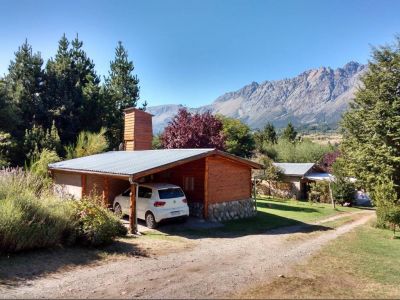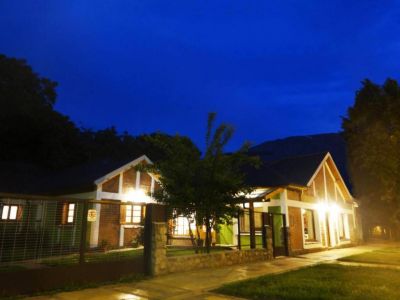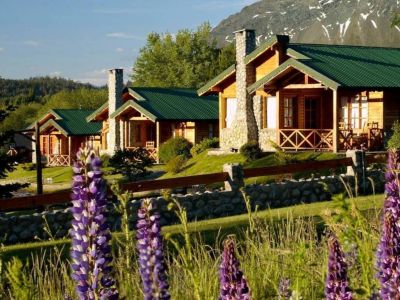When I was invited to make a trip from El MaitĂŠn to the Thomae junction, in the Province of Chubut, on board the Old Patagonian Express, I immediately felt like Detective Pinkerton following the tracks of the famous bandits Butch Cassidy and the Sundance Kid.
Thinking of the locomotive, the black smoke coming out of its chimney, the whistling right before leaving, the wooden car, and the endless rattling of its wheels sliding on the rails, I was rapidly sent back to the cowboy movies from the Far West.
The truth is that, far from being the famous detective and in fact living in the XXI century, I was deeply motivated to have the incredible possibility of getting on the legendary train of the early 1920's, which gave shape to a great part of the Patagonian history.
La Trochita, Through the Time Tunnel
Thanks to the train âpopularly known as the âTrochitaâ, due to the unusual length of the locomotive gage (trocha), measuring only 75 centimetersâ countless towns were born, and it is the testimony in motion of the effort of the people who, in remote times, dared to populate the South of the country.
Totally willing to go on this trip charged with history in a true rolling museum, I accepted the invitation. From the village of El BolsĂłn, I left with the tourist agency transfer vehicle heading for El MaitĂŠn.
We quickly left behind the 42nd. parallel, imaginary boundary between the Provinces of RĂo Negro and Chubut, and entered the latter through National Route 258.
To our left, a silent witness of the adventure we were about to live accompanied us during most of the tour: the PiltriquitrĂłn Mount, 2,260 mosl.
Javier was our guide and therefore he was in charge of providing us with dates, information and topics related to the trip we were being part of. âPiltriquitrĂłn" in the mapuche language means "mount hanging from the cloudsââ he asserted, as the transfer vehicle was leaving the Las Golondrinas spot behind.
A "curtainâ of poplars indicated that we were passing by El Hoyo region, the âNational capital of fine fruitâ. This community, of hardly three thousand inhabitants, received this name due to the excellent quality of its production.
Farther on, our senses were delighted by the sight of a magnificent panoramic view of the EpuyĂŠn Valley. The intense green of the Oregon and ponderosa pines, the busy blue of a stream that surely lost the main course of its river, the impressive mountains that are part of the Andes Mountain Range... everything was forming a postcard that would remain forever in my memory.
The Roots of the Town
We would soon arrive in El MaitĂŠn. This town, located in a valley shaped by glacier erosion, is immersed in an ecosystem known as âecotoneâ, in the very transition of the Andean forest to the Patagonian steppe.
The little town owes its name to the leafy top and perennial leaves tree which in the early XIX century populated the banks of the Chubut River. MaitĂŠn, in the mapuche language, means âsacred treeâ or âtree of wisdomâ.
We went along its arid streets observing its ancient architecture, which seemed to have stopped in time. The first establishments finally settled in the year 1939, when the rails of the "Trochita" arrived in the northern bank of the Chubut River.
We got off the vehicle, and a sharp and intense sound made me vibrate. It was the whistling of the locomotive, which was coupling up the last cars so that they would transport us during the ride.
With Javier, we headed for the workshops where the train maintenance tasks were performed. Inside the workshops, we were given a thorough explanation about the âTrochitaâ.
I was surprised to learn that the train that I was about to take was in its original state. The legendary steam engine Henschel Class 75 H from 1922, still in use, is considered a unique piece by the signature of its own makers.
The locomotive is technically called âsuper economical gageâ, due to the difference in centimeters between one rail and another. The maximum speed reached is thirty-five kilometers per hour, and the minimum is five. To start the engine, the engineer must press a key manually, in order to send the steam from the dome to the piston, which is the part that gives traction to the engine. These characteristics turn the train into one of the most beautiful trains in the world surviving the passing of time.
âAll Aboardâ
We went back to the platform and the conductor's voice told us it was time to set off. I got on the corresponding car -the "Dutch"- and sitting on the comfortable seat I decided to behold the Patagonian landscape.
It is a real pleasure to be able to enjoy the ride in the âOld Patagonian Expressâ. It is like a trip across time, in which you go back to the times when the pioneers settled in this desert frontier, and around which endless anecdotes and stories were woven.
Outside, a landscape of matchless Andean beauty took hold of my senses. Soon, the winding tract let me glimpse that surprises awaited behind every bend.
The dark smoke column, the sound of the locomotive, the narrowness of its cars âeach of them with its corresponding stoveâ and the bar-car, are unique postcards of this railway tourist attraction.
We crossed the rail bridge, and we gradually went deep into enigmatic Patagonia.
The profile of a sleeping woman sculpted in rock by mother nature captured our attention. "That is Sleeping Beauty" -said the guide. We smiled, admired, beheld and suddenly let ourselves be caught by a strange nostalgic feeling that came to us in order to enjoy the utmost of that magnificent exponent of the area: the El MaitĂŠn âTrochitaâ.
Contactos:
DirecciĂłn de Turismo El MaitĂŠn
Av. San MartĂn 922 (9210) El MaitĂŠn- Chubut - Argentina
Tel/Fax: +54 2945 49-5016
informeselmaiten@gmail.com
Ferrocarril El MaitĂŠn
(9210) El MaitĂŠn- Chubut - Argentina
Tel: +54 2945 49-5190
ferroelmaiten@gmail.com
Marcelo Sola
Marcelo Sola






























